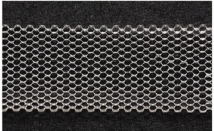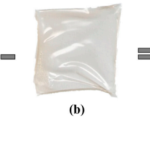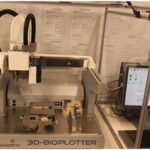

After a person suffers a heart attack, they lose about half the cells in their heart, greatly weakening the organ and increasing the odds that further attacks will occur. Doctors have begun injecting cells into the heart to grow into muscle and help contractions, but 99% of those cells get washed away. But there are alternative approaches – like 3D printing. Scientists have developed 3D printed cardiac patches that can be used to repair hearts damaged by heart attacks, but only about five have been produced worldwide.
In a new study entitled “Melt Electrowriting Allows Tailored Microstructural and Mechanical Design of Scaffolds to Advance Functional Human Myocardial Tissue Formation,” a group of researchers 3D printed a world-first stretchable microfiber scaffold with a hexagonal design. They then added specialized stem cells called iPS-Cardiomyocytes, which began to contract unstimulated on the scaffold. The work was then demonstrated on the actual hearts of pigs.
We spoke with the authors of the paper to learn more about the technology used by the scientists and its implications for the future.
What are the advantages of MEW relative to other technologies?
“Melt Electrospin Writing (MEW) has distinct advantages over other 3D Printing technologies for tissue engineering applications. MEW utilises common thermoplastics used in biomedical engineering, including Polycaprolactone (PCL). The advantage of this approach is that we are able to create microfibres with diameters often in the 10 micron range, but nano-fibres also also achievable. To put this into perspective, a single strand of hair is about 50-100 microns. Printing at such resolutions allows us to mimic the native extracellular matrix (ECM) components, and allows cells to bind onto the small fibres that at similar to collagen fibrils. Additionally, MEW allows for the control over scaffold architecture, creating scaffolds with aligned fibres and controlled fibre diameters. This specific control over architecture, allows us to tailor the mechanical properties, direct cells growth and control the movement of nutrients. Because we can modify the scaffolds properties so well, they are often used to reinforce hydrogels (as a backbone), which are typically much weaker and less tailorable.”
What is the significance of your paper?
“We developed patches with controlled hexagonal micro-fibre structures that had unique flexibility and shape-recovery properties, meaning that the patch can be highly deformed without sustaining damage to its structure or cells. Moreover, such novel paths allowed the maturation of contractile human iPSC-derived cardiomyocytes, which is a breakthrough in creating a functional patch that could match an adult heart. Finally, due to the patch’s flexibility, it can be compressed and pushed through a catheter for delivery in vivo with minimally invasive laparoscopic surgery.”

Why are collagen-based hydrogels so important?
“Collagen is the most abundant protein in the human myocardial tissue and for that reason an ideal biomaterial for use in myocardial tissue engineering.”
How close are we to using 3D printing in a clinical setting?
“There are already reports of 3D printed implants used in clinics, mostly metallic or ceramic based for bone repair. However, in what concerns to our heart patch’s that include biological derived components (new cell therapies, iPSC) we believe a few more years will be required. We need first to demonstrate the efficacy and safety of such approach in animal models, which we are currently planning. Also, important challenges like integration with surrounding tissue will need to be solved: for example, currently the patches can contract autonomously, but we don’t know if they will sync with the beating of the heart once implanted.”
What work will you be doing next?
“We want to concentrate our efforts in conducting more extensive animal studies to assess feasibility and show functional effects, such as improved cardiac function. We also intend to make the patches more complex, by integrating other cell types in the patch.”
Authors of the paper include Miguel Castilho, Alain van Mil, Malachy Maher, Corina H.G. Metz, Gernot Hochleitner, Jürgen Groll, Pieter A. Doevendans, Keita Ito, Joost P.G. Sluijter, and Jos Malda.
Discuss this and other 3D printing topics at 3DPrintBoard.com or share your thoughts below.
[Images: Castilho et al, “Melt Electrowriting Allows Tailored Microstructural and Mechanical Design of Scaffolds to Advance Functional Human Myocardial Tissue Formation,” Advanced Functional Materials, 2018. Copyright Wiley – VCH Verlag GmbH & Co. KGaA. Reproduced with permission.]
If you're looking for affordable 3D visualization services in the USA, our platform provides an ideal solution for all your architectural and real estate needs. Through our service, you can access high-quality 3D renderings at competitive prices without compromising on quality. Whether you need interior visualizations, exterior renderings, or architectural animations, our team ensures that you get professional results that fit within your budget. With our support, you can make your projects visually stunning while saving on costs, all with a quick and straightforward process.
Through our site, you can easily order affordable 3D visualizations for your projects, whether for a residential property, commercial development, or architectural design. We understand the importance of staying within budget, and that's why we offer tailored solutions to ensure you get the best value for your investment. Our experts work efficiently to provide you with realistic, photorealistic 3D images that will elevate your presentations and attract clients, making your property stand out in the market.






